July 11, 2016 • Musings

Imagine this: You never have to say yes to something you’d rather say no to. We all have those sorts of projects, no matter our creative medium. Perhaps it is a commercially viable print (when you’d rather be doing one-of-a-kind work). Perhaps it is “The Nutcracker.” Perhaps it is “Pachelbel’s Cannon.” Perhaps it is a client you’d rather not serve.
Wouldn’t it be nice to say no instead of yes?
The ability to say no in a creative context is total creative empowerment. Financial empowerment works the same way. If you have a bit of an emergency reserve fund, whether you call it an “I quit” fund or something more colorful, you never have to say yes to something just for the money.
Instead you choose to say yes or no to something after weighing all the pros and cons. You may still choose to say yes to something that in an ideal world you’d rather not do. You may choose to sell prints because a subset of your customers find the price point appealing. You may choose to work with a client who drives you crazy because it is steady, reliable work. You may choose to keep your day job because it keeps you engaging with the world on a regular basis. Or because the retirement benefits are fantastic. Or because your employer helps pay your employment taxes.
But in all of those examples, you make the choice. You decide if it is worth it. You aren’t forced to do something simply because you need the money.
This month, we’re talking about Declaring Independence and Financial Freedom. And there is no better way to declare your own creative (and financial) independence than by saving a bit of money here and there.
1. Figure Out Your Savings Goal
The general rule of thumb is to save enough to cover your expenses for at least six months. (Saving enough to cover your expenses for a year is even better.) So if it costs you $2,000 per month to exist as a human (rent, utilities, phone, clothing, food) and another $1,000 per month to reinvest in your creative practice (studio space, classes, insurance, taxes, supplies), your goal would be to save at least $18,000. (Six months x $3,000 per month = $18,000)
If your monthly expenses are higher (say, $6,000 per month), your savings goal must be higher as well. Six months x $6,000 per month = $36,000.
But for many creative professionals, that number feels daunting.
2. Tweak the Number (If Necessary)
If your number makes your stomach churn, start smaller. A lot smaller. Look at your annual budget from a cash flow perspective based on when you think money will come in and when you know money will go out.
Use that information to figure out what you have to have on hand so you can always pay your bills.
For example, maybe most of your sales (cash inflow) happen during the summer, and you know February is always your worst month. Look at what you’ll need to have on hand to cover February’s expenses and use that number as your target.
Once you reach that target, increase it a bit more. Then a bit more after that. Before you know it, you’ll get to the six-month mark. (It just won’t feel as terrifying along the way.)
3. Find a Safe Spot for It
The ideal spot for your emergency reserve fund is a place that is easily accessible… But not too easily accessible. The whole point of having this fund is to access it when you need it. This is not the money you should be investing or putting into an IRA or other retirement account. (Do that, but not with this pot of money.)
This money is for emergencies. And you need to be able to get to it quickly if you have an emergency.
A separate savings account is a good spot to let this amount hang out. Keep it close enough to monitor every month or so, but not so close that you’ll be tempted to use it for non-emergencies.
(Once you’ve saved enough to cover short-term emergencies, then you can start thinking about more interesting investment options for excess cash.)
4. Watch It Grow
Let us know how you do this month… Remember, every little bit helps. It’s going to grow. And it’s going to shrink. (And that’s okay.) As long as you keep moving forward you’ll keep moving toward total financial freedom.


